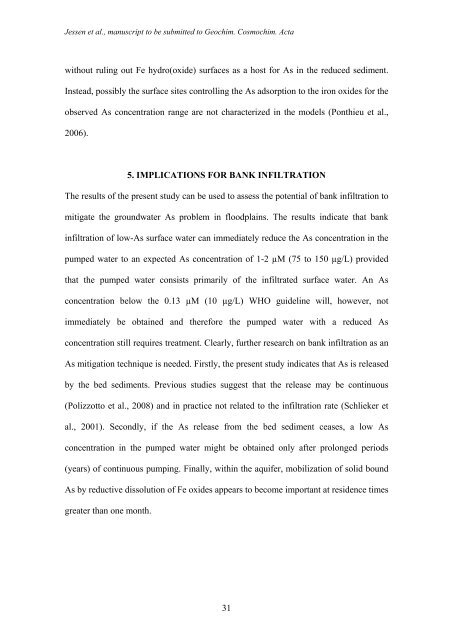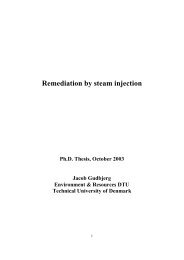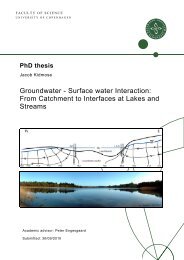Groundwater arsenic in the Red River delta, Vietnam ... - Fiva
Groundwater arsenic in the Red River delta, Vietnam ... - Fiva
Groundwater arsenic in the Red River delta, Vietnam ... - Fiva
You also want an ePaper? Increase the reach of your titles
YUMPU automatically turns print PDFs into web optimized ePapers that Google loves.
Jessen et al., manuscript to be submitted to Geochim. Cosmochim. Acta<br />
without rul<strong>in</strong>g out Fe hydro(oxide) surfaces as a host for As <strong>in</strong> <strong>the</strong> reduced sediment.<br />
Instead, possibly <strong>the</strong> surface sites controll<strong>in</strong>g <strong>the</strong> As adsorption to <strong>the</strong> iron oxides for <strong>the</strong><br />
observed As concentration range are not characterized <strong>in</strong> <strong>the</strong> models (Ponthieu et al.,<br />
2006).<br />
5. IMPLICATIONS FOR BANK INFILTRATION<br />
The results of <strong>the</strong> present study can be used to assess <strong>the</strong> potential of bank <strong>in</strong>filtration to<br />
mitigate <strong>the</strong> groundwater As problem <strong>in</strong> floodpla<strong>in</strong>s. The results <strong>in</strong>dicate that bank<br />
<strong>in</strong>filtration of low-As surface water can immediately reduce <strong>the</strong> As concentration <strong>in</strong> <strong>the</strong><br />
pumped water to an expected As concentration of 1-2 μM (75 to 150 μg/L) provided<br />
that <strong>the</strong> pumped water consists primarily of <strong>the</strong> <strong>in</strong>filtrated surface water. An As<br />
concentration below <strong>the</strong> 0.13 μM (10 μg/L) WHO guidel<strong>in</strong>e will, however, not<br />
immediately be obta<strong>in</strong>ed and <strong>the</strong>refore <strong>the</strong> pumped water with a reduced As<br />
concentration still requires treatment. Clearly, fur<strong>the</strong>r research on bank <strong>in</strong>filtration as an<br />
As mitigation technique is needed. Firstly, <strong>the</strong> present study <strong>in</strong>dicates that As is released<br />
by <strong>the</strong> bed sediments. Previous studies suggest that <strong>the</strong> release may be cont<strong>in</strong>uous<br />
(Polizzotto et al., 2008) and <strong>in</strong> practice not related to <strong>the</strong> <strong>in</strong>filtration rate (Schlieker et<br />
al., 2001). Secondly, if <strong>the</strong> As release from <strong>the</strong> bed sediment ceases, a low As<br />
concentration <strong>in</strong> <strong>the</strong> pumped water might be obta<strong>in</strong>ed only after prolonged periods<br />
(years) of cont<strong>in</strong>uous pump<strong>in</strong>g. F<strong>in</strong>ally, with<strong>in</strong> <strong>the</strong> aquifer, mobilization of solid bound<br />
As by reductive dissolution of Fe oxides appears to become important at residence times<br />
greater than one month.<br />
31





